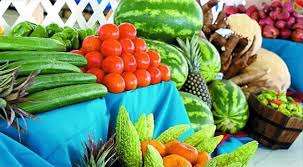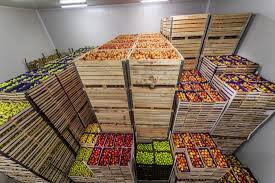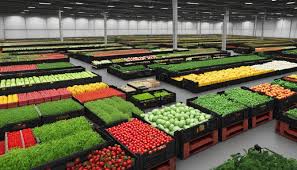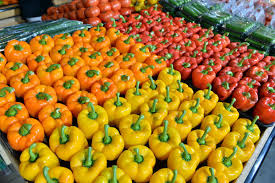Storage is the art of keeping agricultural materials in a manner that maintains their quality and prevents deterioration for a specific period, beyond their normal shelf life. Different crops are harvested and stored by various means depending on the intended use.
Whether the seed is to be used for new plantings the following year, for forage processed into livestock feed, or for crops meant for special uses, the grower must be aware of the harvesting and storage requirements to maintain quality.
After determining the intended use for the crop, timing for harvest and storage becomes an important consideration. Along with deciding when to harvest, the method of harvesting must also be determined.
Farm products are susceptible to attack by insect pests after harvesting if not properly stored. To reduce pest incidence and avoid spoilage, agricultural products are kept in designated storage areas for short or long periods, depending on when they are intended for market or use as input for the next planting season.
During storage, pests and microorganisms are effectively kept from harvested agricultural products to avoid spoilage.
Read Also : How to Plant Fruit Trees for Optimum Performance
Storage of Farm Produce for Future Use

Storage refers to the process of preserving agricultural products for future use as food, raw materials, fuel, or to maintain their original state. It is a crucial phase of the post-harvest system during which products are kept in conditions that ensure food security beyond production periods.
Reasons for Storing Farm Produce
The reasons for storing farm products include the following:
1. Ensuring Year-Round Availability of Food: Storage helps maintain food availability throughout the year at affordable prices.
2. Minimizing Spoilage: Proper storage minimizes food spoilage caused by pests and diseases.
3. Preserving Planting Material for Future Seasons: Part of the harvest serves as propagation material for the next crop. If seeds or tubers are not stored well, germination rates decrease, which may require planting more seeds to achieve a sufficient crop yield.
4. Maintaining or Preserving Food Quality: Good quality food is essential for health. Inadequate storage may cause the loss of vital nutrients in food products, leading to potential health issues and malnutrition.
5. Supplying Raw Materials for Industry Processing: Storage ensures an adequate supply of raw materials for processing industries.
6. Large-Scale Processing Provision: Adequate storage facilities allow for large-scale processing of farm produce.
7. Price Control and Regulation: Storage enables the regulation of market prices by controlling the supply of produce.
8. Optimizing Farmer’s Gain: Proper storage helps farmers achieve better financial returns.
9. Export Opportunities: Stored produce can also be prepared for export, contributing to foreign exchange.
Types of Storage Systems in Agriculture

Storage systems are classified based on various factors such as the duration of storage, scale of storage, and principle of operation.
Classification Based on Duration of Storage
Storage systems can be classified as short-term, medium-term, or long-term storage.
1. Short-Term Storage: This type of storage is used for products that do not last beyond six months. Highly perishable items like eggs, meat, fish, and dairy products require short-term storage. High loss of quality is common unless controlled systems are used.
2. Medium-Term Storage: Medium-term storage maintains product quality for up to 12 months. Products stored for more than 18 months may experience deteriorating quality.
3. Long-Term Storage: This type ensures that stored products remain viable for more than five years. Germ banks and certain storage systems can preserve the quality of materials for decades.
Classification Based on Scale of Storage
Storage systems are also classified based on their scale, which can be small, medium, or large scale.
1. Small-Scale Storage: Small-scale storage systems have capacities of up to 1 ton, typically used at domestic and peasant levels.
2. Medium-Scale Storage: Medium-scale storage systems can accommodate up to 100 tons. These systems are commonly used in breweries or by farmers with moderate-scale production.
3. Large-Scale Storage: Large-scale storage systems are designed to store hundreds to thousands of tons. They are used for the temporary or permanent storage of large quantities of various products and require high initial investment but reduce overall production costs.
Classification Based on Principle of Storage Operation
Storage systems can also be classified by their operational principles: physical, chemical, and biological storage.
1. Physical Storage: This system relies on physical conditions like moisture content, temperature, and relative humidity to preserve stored products. Examples include cold storage and controlled environments.
2. Chemical Storage: This method uses chemicals to prevent deterioration or insect infestation in stored products. Examples include waxes, atelic, or phosphorene dust. However, some chemicals are toxic and require strict monitoring.
3. Biological Storage: Biological storage uses microorganisms to prevent deterioration or enhance the shelf life of stored products. This method is an example of biotechnology application in agriculture.
Read Also: The Alfalfa Petals: Economic Importance, Uses, and By-Products
Storage Considerations for Farm Produce

Most agricultural products are not consumed immediately after harvest for various reasons, requiring them to be stored for some time. The main challenge is to prevent deterioration and maintain quality during storage. Important considerations include:
1. Harvesting Time: For some crops like tubers and bulbs, it is ideal to wait until they are ready for consumption, but most products should be harvested at maturity to prevent quality degradation and reduce pest and disease risks.
2. Field Storage Risks: Leaving harvested products in the field is risky due to uncontrollable conditions, such as weather and pests. For example, seeds for planting should not be exposed to temperatures above 40-45°C.
3. Handling and Packaging: Some products are easily bruised during harvesting and transportation. Proper handling and packaging are essential to prevent injuries and ensure quality.
4. Drying Conditions: Seeds that need drying should be placed in well-ventilated spaces. If the weather is humid, artificial drying methods should be employed to prevent damage.
5. Refrigeration and Ventilation: While refrigeration is suitable for some products, it is typically used only for expensive or small-volume items. Products that respire should not be stored in airtight containers, while those that do not require airtight storage.
6. Humidity Control: Moisture content must be carefully managed during storage, especially for products prone to fungal and bacterial growth. Seeds with high moisture levels should be stored in conditions that allow continued drying.
7. Ethylene Gas Considerations: Fruits that produce ethylene gas during ripening should not be stored with other fruits and vegetables, as ethylene accelerates ripening.
8. Regular Inspection: It is important to inspect stored products regularly to detect early signs of deterioration and pest infestations.
9. Preservation for Longer Shelf Life: If the harvested volume exceeds immediate consumption needs, preservation techniques can be applied to extend the shelf life of the produce.
Effective storage systems are vital for maximizing the value and longevity of agricultural products, contributing to food security, and supporting economic growth.
Storage of Seeds/Grains
Seeds are essential for plant propagation and survival, providing a means for species to endure unfavorable growing conditions between seasons.
They consist of an embryo, a food reserve to support the embryo’s growth, and a protective coat. Under optimal conditions, the embryo germinates and uses the food reserve to grow into a new plant.
If seeds remain dry, they preserve their viability and can be stored for extended periods. Both seeds for planting and for consumption need effective storage methods to ensure their quality.
1. Challenges in the Storage of Seeds/Grains
The primary challenge in seed storage is drying, which serves two key purposes. First, drying halts respiration, preventing seeds from losing their nutritional value (for food) or their germination capacity (for planting). Second, drying inhibits spoilage by bacteria and fungi.
If seeds are too moist when stored, they become vulnerable to microbial damage, raising temperatures and leading to spoilage. Therefore, maintaining a moisture content of no more than 13% for food grains and 15% for pulses is crucial.
For storage of seeds for planting, the moisture level should ideally be even lower, but caution is needed since overly dry seeds can become brittle.
Another challenge is preventing pest damage. Insects, rodents, and birds pose significant threats to stored seeds. Effective pest control is necessary, especially without the use of harmful pesticides.
Moreover, extreme heat (above 40°C for grains or 35°C for pulses) can destroy seed viability, making temperature control essential during harvest and storage.
2. Practical Operations Preparatory for Storage of Seeds/Grains
i. Harvesting Time and Method
Harvesting at the right time is crucial for optimal seed storage. If seeds are harvested too early, they will have high moisture content, making drying and storage difficult. If harvested too late, seeds may be damaged by pests, disease, or weather conditions.
To prevent these risks, harvesting should ideally occur when seeds reach physiological maturity, indicated by the completion of the embryo and a reduction in moisture content. Seeds can often be harvested slightly early and dried artificially to avoid these issues. For crops with high value, early harvesting and artificial drying might be worth the effort to prevent losses.
ii. Drying Seeds
Dry weather with mild wind is ideal for drying seeds. The temperature should not exceed 35°C, as high heat can break grains or kill the seed embryo. Only cereals can tolerate higher temperatures (40-45°C). It is essential to dry seeds in the shade, away from direct sunlight, to avoid detrimental heat effects. During rainy periods, seeds should be dried indoors to avoid rehydration.
For crops like maize, seeds must be dried while still on the cob since the moisture content is too high for threshing. Specific drying buildings may be used for this purpose, and pests must be controlled during this process. Once seeds have reached the safe moisture content, they can be threshed and stored in containers to minimize space and prevent further moisture loss.
Oilseeds like groundnuts, soybeans, and sesame require field drying, with the foliage attached, to a moisture content of about 15%. This ensures the seeds are strong enough to be handled without breakage and pest invasion.
iii. Threshing
Threshing is an essential process that is almost identical across different types of seeds. It typically occurs when the seeds have reached a desirable moisture level, which may happen either in the field or after additional drying indoors.
It’s crucial to handle seeds gently during threshing to prevent damage, especially with sensitive crops like pulses. Harvesting a little early can help, as seeds with slightly higher moisture content are easier to handle.
However, too much moisture is detrimental, leading to internal damage. After threshing, further drying is needed before winnowing and cleaning.
For small-scale threshing of pulses, a simple method involves placing the pods in bags and hitting them with sticks. Avoid trampling or running over the pods, as this causes significant damage.
Groundnuts are an exception, as they are best stored in the pod until planting time. Hand threshing (shelling) is the most reliable method for groundnuts used as seed.
When threshing cereals for seed, the process is similar to that for food. Maize, for example, can be stored on the cob in small quantities by bundling and hanging indoors. Larger quantities require a crib for proper storage.
Threshing often involves removing soil, stones, chaff, and other debris, and cleaning is necessary to ensure the seed is free of weed seeds, insects, or damaged seeds. This cleaning can be done by hand or mechanically, with machinery being necessary for larger quantities.
Careful attention to weed seeds and unhealthy crop seeds those that are discolored, broken, shriveled, or attacked by insects should be prioritized during cleaning and sorting.
For crops like groundnuts, soybeans, and sesame, threshing should occur when the moisture content is around 15%. Hand picking is sometimes used to reduce damage and the risk of fungal growth and aflatoxin contamination.
Storage of Roots, Tubers, and Bulbs
Roots, tubers, and bulbs, including crops like cassava, sweet potatoes, potatoes, and yams, require special care for storage due to their high moisture content (60-80%).
Unlike seeds, they cannot be dried extensively without losing their structural integrity. Proper storage is essential to maintain their freshness and usability throughout the year.
1. Challenges in Storage
One major challenge in storing roots, tubers, and bulbs is balancing humidity. While excessive humidity can lead to rotting, insufficient humidity causes the produce to dry out (desiccate). Roots and tubers continue to respire (breathe), and when this process is combined with higher temperatures, it can result in damaged plant tissue.
For example, potatoes can develop black hearts if stored in poor conditions. Therefore, it’s crucial to provide adequate ventilation during storage.
The storage life of tubers varies by species. For example, yam tubers can be stored for up to four months at normal temperatures without sprouting, while potatoes begin sprouting after about five weeks at 15°C.
Lower temperatures are beneficial for preventing both desiccation and rotting, as long as temperatures don’t drop below freezing. In practice, this means ensuring the storage environment remains as cool as possible while also being well-ventilated.
For non-refrigerated storage, it’s essential to focus on cooling the storage area, especially during the cooler parts of the day. Insulation may help trap cool air, although this requires a well-constructed storage room. On the other hand, in naturally ventilated storage, temperature regulation is more difficult to manage.
2. Practical Operations for Preparing Storage
i. Harvesting: Harvesting at the right time is critical. While certain crops like cassava can remain in the ground during the dry season, leaving them too long can affect their quality. Tubers should be harvested when they are at their peak to avoid over-ripening and potential pest infestations.
ii. Pre-Harvest Pruning: For cassava, pre-harvest pruning of leaves helps extend storage life by reducing the amount of moisture lost from the plant. Removing leaves a few weeks before harvest can improve root storage and reduce the risk of rotting.
iii. Preventing Injuries: Damage during harvesting and transportation accelerates rotting. Therefore, using wooden tools and avoiding rough handling is essential to prevent injury to the tubers and roots. In some cases, damaged tubers can be treated with wood ash or lime to prevent rot.
3. Curing of Roots and Tubers
Curing is an important process to prepare tubers for long-term storage. Tubers should be stored under warm (25-35°C) and humid (85-95%) conditions for several days. This allows a protective layer to form around the tubers, reducing moisture loss and preventing fungal infections.
While curing in direct sunlight is quicker, it’s preferable to protect the tubers from sun exposure to maintain humidity levels. For example, cassava roots are cured for 4-7 days at temperatures around 30-35°C.
Sweet potatoes and yams are also cured similarly, with varying durations and conditions based on the specific crop. Damaged tubers should be healed before curing to prevent further deterioration.
Curing conditions must be managed carefully to prevent the formation of harmful conditions like excessive heat, which can decrease the shelf life of the produce.
4. Curing of Bulbs
Bulb crops, such as onions, require different curing conditions than tubers. Curing for bulbs involves drying them in a hot, well-ventilated environment with low humidity. This drying process helps to preserve the bulb and extend its storage life.
For onions, curing is complete when the neck tightens and the outer layers dry out, typically after a loss of 3-5% of the bulb’s weight. In climates with cooler, damp conditions, onions should be stored in ventilated rooms, where they can be dried with controlled airflow.
After curing, bulbs should be graded to remove damaged or decayed bulbs. Proper sorting and grading not only ensure better storage quality but also improve marketability and reduce losses during storage.
5. Factors Affecting the Storage of Farm Produce
Several factors influence the success of storage for farm produce, including:
- Quality of the product: Proper storage depends on the quality of the produce. Before storage, cleaning is essential to remove impurities such as dirt, broken seeds, and other crop residues.
- Environmental factors: Temperature, moisture, humidity, and light all play critical roles in how long farm produce can be stored without deterioration. Lowering temperatures helps preserve produce, but care must be taken not to freeze items that are sensitive to cold.
- Biological factors: The biological processes of respiration, transpiration, and ethylene production can all cause deterioration in stored produce. Reducing oxygen levels and managing humidity can slow down respiration and ethylene production, which helps extend storage life. Additionally, preventing water loss through transpiration is essential to maintaining produce quality.
- Do you have any questions, suggestions, or contributions? If so, please feel free to use the comment box below to share your thoughts. We also encourage you to kindly share this information with others who might benefit from it. Since we can’t reach everyone at once, we truly appreciate your help in spreading the word. Thank you so much for your support and for sharing!

